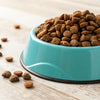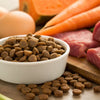Is Fresh Food or Kibble Better for Dogs? A Comprehensive Analysis
- Houndsy
Table of Contents
- Introduction
- What Constitutes Fresh Dog Food?
- Advantages of Fresh Food
- Disadvantages of Fresh Food
- Understanding Kibble and Its Nutritional Profile
- Advantages of Kibble
- Disadvantages of Kibble
- Cost Comparison: Fresh Food vs. Kibble
- Convenience Factor: Which is Easier to Feed?
- Recommendations for Choosing the Best Diet for Your Dog
- Conclusion
- FAQs
Introduction
As loving dog owners, we often find ourselves pondering the best ways to nourish our furry friends. Did you know that, according to a recent survey, nearly 40% of pet owners are considering switching their dogs to a fresh food diet? With this growing trend towards fresh, minimally processed meals, we may wonder: is fresh food or kibble better for dogs?
In this blog post, we will explore the intricacies of both fresh food and kibble, examining their nutritional values, benefits, and potential drawbacks. We'll also discuss how each option aligns with our mission at Houndsy to simplify and elevate the dog-feeding experience. By the end of this post, we aim to provide you with a well-rounded understanding of these two popular dog food choices, helping you make informed decisions that support your pet’s health and well-being.
We’ll cover the following areas:
- What constitutes fresh dog food?
- The advantages and disadvantages of fresh food.
- Understanding kibble and its nutritional profile.
- Comparing the cost, convenience, and palatability of both options.
- Recommendations for choosing the best diet for your dog.
As we delve into this topic, we encourage you to reflect on your own dog's eating habits and preferences. Are they thriving on kibble, or do they seem to have a discerning palate for fresh food? Let’s explore the options together!
What Constitutes Fresh Dog Food?
Fresh dog food typically refers to meals made with whole, natural ingredients like meats, vegetables, and grains, often cooked at lower temperatures to preserve their nutritional integrity. These meals are usually labeled as "human-grade," meaning they meet FDA standards for human consumption. Unlike kibble, fresh dog food is minimally processed, which can lead to higher nutritional value and digestibility.
Types of Fresh Dog Food
- Cooked Fresh Food: Prepared and cooked before being packaged, these meals retain their natural flavors and nutrients.
- Raw Diets: These consist of uncooked meats, vegetables, and bones, although caution is required due to potential health risks from bacteria.
- Freeze-Dried or Dehydrated: These options maintain the nutritional value of fresh ingredients while extending shelf life.
Nutritional Profile
Fresh dog food often contains:
- High-quality protein sources (e.g., chicken, beef, lamb)
- Fresh vegetables (e.g., carrots, peas, spinach)
- Healthy grains or carbohydrates (e.g., brown rice, sweet potatoes)
However, it’s essential to choose brands that formulate their diets with veterinary nutritionists to ensure that all nutritional needs are met adequately.
Advantages of Fresh Food
- Easier Digestion: Fresh food tends to be more digestible compared to processed kibble, especially for dogs with sensitive stomachs.
- Higher Nutritional Value: Fresh foods can contain more bioavailable nutrients, leading to better health outcomes over time.
- Palatability: Many dogs find fresh food appealing due to its aroma and texture, which can be beneficial for picky eaters.
- Fewer Preservatives: Fresh foods typically have fewer artificial additives, benefiting dogs with allergies or sensitivities.
Disadvantages of Fresh Food
- Cost: Fresh dog food is often more expensive than kibble, making it a less viable option for budget-conscious pet owners.
- Storage: Fresh food requires refrigeration and has a shorter shelf life, which can complicate feeding routines.
- Nutritional Imbalance: Not all fresh dog foods are created equal; some may lack essential nutrients unless properly formulated.
- Risk of Contamination: Homemade fresh meals or improperly handled commercial options can carry risks of foodborne illness.
Understanding Kibble and Its Nutritional Profile
Kibble, or dry dog food, is a staple in many households due to its convenience and affordability. Kibble is made by mixing ingredients, cooking them together, and then shaping them into dry pieces.
Nutritional Profile
High-quality kibble typically contains:
- A primary protein source (e.g., chicken, lamb)
- Carbohydrates (e.g., grains, legumes)
- Essential vitamins and minerals
Kibble is formulated to meet AAFCO (Association of American Feed Control Officials) standards, ensuring that dogs receive balanced nutrition.
Advantages of Kibble
- Convenience: Kibble is easy to store, measure, and serve, making it ideal for busy pet owners.
- Cost-Effectiveness: Generally, kibble is less expensive than fresh food, allowing for bulk purchasing without breaking the bank.
- Long Shelf Life: Kibble can be stored at room temperature for extended periods without spoiling, making it practical for long-term feeding.
- Dental Health Benefits: Some kibble varieties are designed to reduce plaque and tartar buildup, promoting better oral hygiene.
Disadvantages of Kibble
- Processing Concerns: Kibble undergoes high-temperature processing, which can reduce nutrient levels and digestibility.
- Lower Nutritional Value: In some cases, kibble may contain fillers or low-quality ingredients that do not provide optimal nutrition.
- Less Appealing: Some dogs may prefer the taste and texture of fresh food, leading to a lack of enthusiasm during mealtime.
Cost Comparison: Fresh Food vs. Kibble
It's essential to consider your budget when evaluating dog food options. Fresh food generally costs more than kibble, with prices typically ranging from $2 to $4 per day, depending on the brand and ingredients. In contrast, kibble can cost as little as $0.25 to $1 per day, making it a more accessible option for many pet owners.
Cost Breakdown Examples
- Fresh Food (Ollie): Approximately $4 per day for a balanced meal plan.
- Kibble: Ranges from $0.25 to $1 per day, based on the quality and brand.
Convenience Factor: Which is Easier to Feed?
When it comes to convenience, kibble has a clear edge. It requires no preparation, can be left out longer without spoilage, and is easy to travel with. Fresh food, while nutritious, often requires thawing, refrigeration, and careful handling.
Feeding Routines
- Kibble: Simply scoop into a bowl and serve.
- Fresh Food: Requires defrosting and may need to be served within a specific timeframe to avoid spoilage.
Recommendations for Choosing the Best Diet for Your Dog
Ultimately, the best diet for your dog will depend on their individual needs, lifestyle, and health conditions. Here are some considerations to help guide your decision:
- Consult Your Veterinarian: Always discuss dietary changes with a veterinarian to ensure that your dog’s nutritional needs are met.
- Evaluate Health Conditions: Dogs with specific health issues may benefit from fresh food or specialized kibble.
- Consider Your Budget: Weigh the costs of fresh food versus kibble and choose what fits your financial situation.
- Observe Your Dog’s Preferences: Pay attention to your dog’s eating habits. Do they seem to thrive on kibble, or do they appear more excited about fresh meals?
Conclusion
In our pursuit to provide the best for our canine companions, we must weigh the pros and cons of fresh food and kibble. While fresh food offers high nutritional value, easier digestion, and palatability, kibble remains a convenient, cost-effective option that many dogs thrive on.
Remember, every dog is unique, and their dietary needs can vary based on factors like age, activity level, and health conditions. We encourage you to take the time to explore the options available and consult with your veterinarian.
As we at Houndsy strive to elevate dog feeding experiences, our flagship product, the Houndsy Kibble Dispenser, exemplifies our commitment to convenience, design excellence, and pet well-being. It allows for perfect portion control and complements modern home decor, making kibble feeding a more enjoyable experience.
FAQs
1. Is fresh food better for dogs than kibble? It depends on the individual dog's needs. Fresh food can be more nutritious but may not suit every dog.
2. Can I mix fresh food with kibble? Yes, many dog owners choose to mix the two to provide variety and balance in their dog’s diet.
3. How can I ensure fresh food is nutritionally balanced? Select brands formulated by veterinary nutritionists and check for AAFCO compliance.
4. What is the cost difference between fresh food and kibble? Fresh food typically costs more, ranging from $2 to $4 per day, while kibble can cost $0.25 to $1 per day.
5. How should I transition my dog to a new diet? Introduce the new food gradually over a week or two, mixing it with their current food to avoid digestive upset.
By understanding the differences between fresh food and kibble, we can make informed choices that contribute to the overall health and happiness of our beloved pets.













